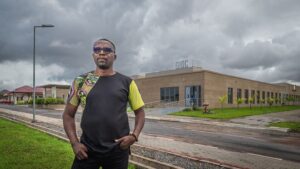…How Ghana’s industry professionals synergised to respond to the COVID-19 pandemic by constructing an Infectious Disease Centre in just 100 days
MARCH 2020 – It’s 1am and Accra is asleep. For a few hours, city dwellers could bury their worries – including COVID-19, which ranked high on their list. For a few building industry professionals, architects, engineers, surveyors and planners, however, sleep was a luxury. They were stuck on site, having volunteered their time and expertise to construct Ghana’s first infectious disease centre in response to the COVID-19 pandemic. Working round the clock, these professionals looked to deliver a 100-bed facility in just 100 days. A commendable ambition which was realised when the facility was inaugurated by Vice President Mahamudu Bawumia on 24th July 2020. The facility, which is currently operated by the Ministry of Health, is truly a testament to the power of collaboration.
Rallying the ‘generals’
Architect Kofi Essel-Appiah, an industry professional, coordinated the collaboration of his built environment colleagues who donated their time and expertise to design and construct the facility. He acted in a dual capacity as co-Project Manager and a Lead Consultant. He shares his part of the Ghana Infectious Disease Centre (GIDC) story:
“My key challenge was risking my life and that of my family by working on a COVID project in a COVID centre with all the attendant risks. However, Ghana needed our sacrifice, and I had to galvanise a team of very experienced consultants from the built environment to sacrifice time, professional skills and, indeed, their lives to deliver a much-needed project. My daily schedule was a full one; together with my ‘generals’ from the Ghana Institute of Architects, Ghana Institution of Engineering, Ghana Institution of Surveyors, and Ghana Institute of Planners, we worked tirelessly and intensively in shifts – day and night – to deliver the GIDC project in international record time.”
Some technical solutions deployed included insulation of the roof and external walls, water-efficient landscaping, and low-flow showerheads and faucets in bathrooms. Material solutions included a mix of reinforced concrete slab for the floor, concrete filler slab with Polystyrene blocks and steel sheets on timber rafters for the roof as well as 3-D wire panel with ‘shot-crete’ on both sides for internal and external walls. Upon completion, the facility received EDGE Certification, covering 3,623.61 sqm of floor space.

Architect Essel Appiah believes EDGE was a valuable tool in quickly assessing the greenness of the GIDC project and subsequently aiding the iterative processes of design to achieve certification. The EDGE App enabled design modelling and simulations, and with the knowledge that hospitals operating 24/7 consume 2.5 times the energy of an equivalent commercial building, the team ensured low cost of cooling, no loss of energy as well as good water-saving measures. After two years, the gains include running cost savings of 30 percent, the predicted efficiency measures included 246.32 MWH/year of energy and 3,547.84 cubic metre/year of water savings.
The power of collaboration
To raise funding for the project, which reported cost of US$7.5million, within that short timeline was always going to require thinking out of the box. Senyo Hosi, who was then CEO of the Chamber of Bulk Oil Distributors, led the Private Sector Trust Fund as the managing trustee, and played a pivotal role in leading the trust fund to resource the project. He recalled that the conception of the project began at a meeting with built professionals on April 9, 2020; and three days later, the base design was ready to advance plans for construction execution. The teams were also mobilised to complete construction procurement and substructure drawings to secure approvals for site entry and construction commencement, all within three days. The concern was pressing as Mr. Hosi noted: “We were all convinced about the urgency of the project to save as many lives as possible, and therefore, lived with the mantra: ‘Every day we delay is a life we may be throwing away’”.
Though the project was able to meet its timelines, it had to overcome a few challenges, which made the project delivery on time, cost and quality even more commendable. Construction took place at a time when countries were on lockdowns at different times, and this posed both global and local supply chain challenges. There were also nine reported COVID cases on site, which increased anxiety and nervousness at the height of the pandemic.
While built industry and business professionals led at the front, the project is testament to the Ghanaian spirit of community and resilience, rising above odds in difficult times. This was evidenced in the support enjoyed across different income groups and sectors who contributed financially to support the project, from as little as 66 pesewas to GH₵10million. At the very core, the GIDC is truly a Ghanaian project that succeeded on the tenet of collaboration.










